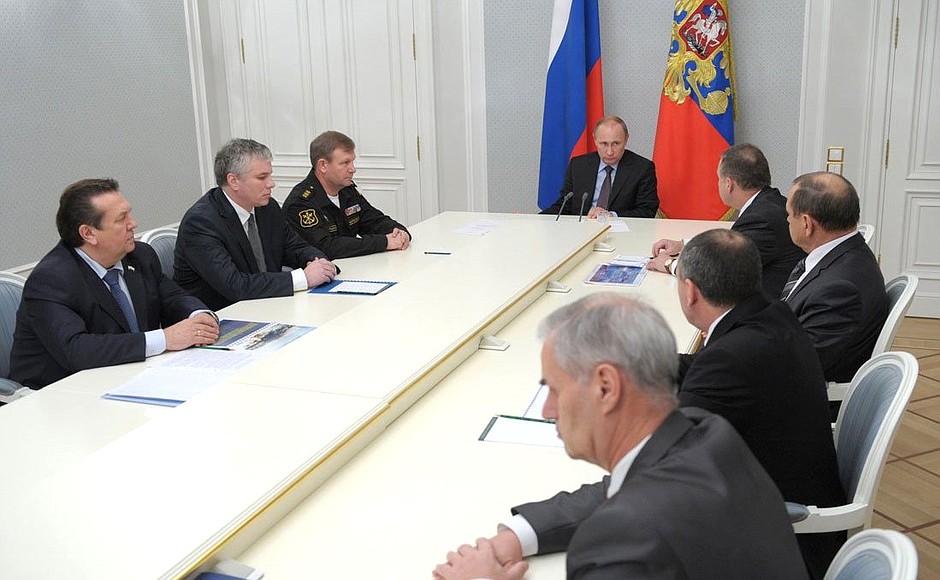
President of Russia Vladimir Putin: Colleagues,
We will continue our meeting [on strategic missile forces] in reference to the Navy. I don’t need to talk about how important the naval component is within our three-pronged strategic nuclear deterrence forces. In Russia the Armed Forces, including strategic nuclear deterrence forces, must be balanced; for this reason we intend to and shall pay appropriate attention to the Navy in general, and its strategic component in particular.
As you know, in January 2013 the new nuclear-powered missile cruiser Yury Dolgoruky was commissioned into the Navy. Next year, in the near future, two more boats – Alexander Nevsky and Vladimir Monomakh – will be commissioned in, and by 2020 eight nuclear-powered submarines will be deployed.
What would I like to draw attention to? To deadlines, prices, and harmonising work to build and modernise the fleet, with that related to weapons. Weapons must become available simultaneously with the release of the carriers themselves, the submarines. And of course, coastal infrastructure too; but we talked about this with the Navy Commander and the Defence Minister, and today we’ll discuss it in even more detail.
I would like Mr Vilnit to say a few words, and then Mr Dorofeyev.
Please go ahead.
CEO of Rubin Central Design Bureau For Marine Engineering Igor Vilnit: Mr President,
The Borei class strategic submarine cruiser has been built. The lead ship under this project has been commissioned into the Navy.
The first serial Borei class ship has completed the necessary tests, including state ones, and today is being prepared for deployment in the Navy.
The second ship under this project is currently undergoing sea trials; once those are finished it will undergo state tests later on this year.
At present, work is underway to create the new modernised Borei-A project, which provides for a whole range of improvements for Borei design ships.
Work to create such a ship is underway. All enterprises involved know their tasks and are ready to supply the appropriate weapons. Ongoing work to build these ships is proceeding according to plan.
Today non-nuclear ships are also being built for our Navy. All the work to build 636 and 677 Lada class submarines is being carried out according to plan.
Simultaneously, work is underway to establish a special air-independent propulsion power plant for these vessels, in order to significantly improve their capacities for future fifth-generation ships.
Vladimir Putin: Thank you.
CEO of Malachite Central Design Bureau For Marine Engineering Vladimir Dorofeyev: Mr President,
This year state tests of the Severodvinsk multipurpose nuclear submarine, the lead ship of the Project 885 [Yasen class] submarines, have been completed. Ongoing state tests are now finished.
During these tests we successfully simulated missile launches, both cruise missiles designed to destroy surface ships, and those designed to destroy long-range coastal targets.
Once this ship is deployed, our Navy, Defence Ministry, and the state will be able to use it to carry out a new function, namely non-strategic nuclear deterrence through the use of high-precision long-range cruise missiles.
Dozens of industrial enterprises and scientific organisations participated in building this ship, which was done at the Sevmash shipyard. That was my report.
Vladimir Putin: In October some submarines left the shipyard docks. In general, everything went very well. How would you evaluate this work?
Russian Navy Commander Admiral Viktor Chirkov: Comrade Commander-in-Chief,
Under your leadership, we carried out strategic military exercises to manage our strategic nuclear forces. During these we conducted missile firing exercises in the Sea of Okhotsk and the Barents Sea. Shooting exercises were completed normally, and all deviations were also within normal limits. Personnel accomplished the tasks they were set. The goals of these exercises were achieved.
Vladimir Putin: Good, thank you.
<…>